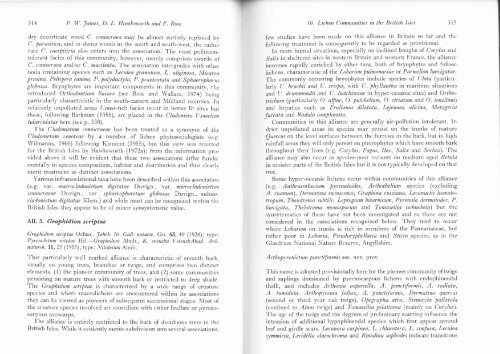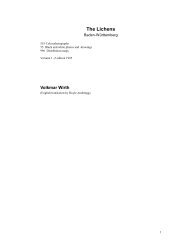Lichen communities in the British Isles: A preliminary conspectus
Lichen communities in the British Isles: A preliminary conspectus
Lichen communities in the British Isles: A preliminary conspectus
Create successful ePaper yourself
Turn your PDF publications into a flip-book with our unique Google optimized e-Paper software.
314 P. W. James, D. L. Hawkszoorth and F. Rose<br />
dry dccorticate wood C. coniocraea rnay be almost entirely replaced by<br />
C. parasitica, and <strong>in</strong> damp woods i'<strong>the</strong> south and south-west, <strong>the</strong> ra<strong>the</strong>r<br />
rare c. caespiticia also cntcrs <strong>in</strong>to <strong>the</strong> association. The most pollutiontolerant<br />
facies of this community, however, merely compriscs swards of<br />
c. coniocraea andlor c. macilenta. The association <strong>in</strong>tergrades with othcr<br />
noda conta<strong>in</strong><strong>in</strong>g species such as Lecidea granrtlosa, L. ulig<strong>in</strong>osa, Micar.ea<br />
prasirttt, Peltigera can<strong>in</strong>a, P. polydactyla, P. praetextata and Sphaerophonts<br />
globosus. Bryophytes are important components <strong>in</strong> this community, <strong>the</strong><br />
<strong>in</strong>troduced Orthodontium l<strong>in</strong>eare (see Rose and Wallace, 1974) bc<strong>in</strong>g<br />
particularly characteristic <strong>in</strong> <strong>the</strong> south-eastern and Midland counties. In<br />
relatively rrnpolluted areas (lsnea-rich facies occur <strong>in</strong> better lit sites but<br />
<strong>the</strong>se, follorv<strong>in</strong>g Barkman (1958), are placed <strong>in</strong> <strong>the</strong> Cladonieto (.isneettLm<br />
tnberculatae here (see p. 338).<br />
The Cladonietum coniocraeae has been treated as a synonym of <strong>the</strong><br />
Cladonietum cenoteae by a number of lichen phytosociologists (e.g.<br />
Wilmanns, 1966) follorv<strong>in</strong>g Klement (1955), but this vierv was rejectecl<br />
for <strong>the</strong> llritish <strong>Isles</strong> by Hawksworth (1972a);from <strong>the</strong> <strong>in</strong>formation provided<br />
above it will be evident that <strong>the</strong>se two associations differ fundamentally<br />
<strong>in</strong> species composition, habitat and distribution and thus clearlv<br />
merit treatment as dist<strong>in</strong>ct associations.<br />
\rarious <strong>in</strong>frassociational taxa have been described vvith<strong>in</strong> this association<br />
(..g. var. macrocladonietum digitatae Duvign., yar. microcla.donietrnrt<br />
coniocraeae Duvign., var. sphaerophoretum globosae Duvign., subass.<br />
cladonietum digitatae Klem.) and while most can be recognized with<strong>in</strong> thc<br />
Ilritish <strong>Isles</strong> <strong>the</strong>y appear to be of m<strong>in</strong>or synsystematic value.<br />
All. 3. Graphidion scriptae<br />
Gral>ht)dion scriptae Ochsn., Jahrb. St. Gall. naturw. Ges.63,49 (1928); type:<br />
Pyrenuletum nitidae Htl.-Graphidioz Almb., K. svensha VetenshAhad. Azth.<br />
natursk. 11, 21 (1955); type: Nitidetum Llmb.<br />
This particularly r,vell marked alliance is characteristic of smooth bark,<br />
usually on young trees, branches or twigs, and comprises two dist<strong>in</strong>ct<br />
elements, (1) <strong>the</strong> pioneer community of trees, and (2) some <strong>communities</strong><br />
persist<strong>in</strong>g on mature trees lvith smooth bark or restricted to deep shade.<br />
The ()rapltidion scrilttae is characterized by a wide range of crustose<br />
specics and where macrolichens are encountered with<strong>in</strong> its associations<br />
<strong>the</strong>y can be viewed as pioneers of subsequent successional stages. Most of<br />
<strong>the</strong> crustose species <strong>in</strong>volved are esorediate with ei<strong>the</strong>r lirellate or pyrenocarpous<br />
ascocarps.<br />
The alliance is entirely restricted to <strong>the</strong> bark of deciduous trees <strong>in</strong> <strong>the</strong><br />
Btitish <strong>Isles</strong>. While it evidently merits subdivision <strong>in</strong>to several associations,<br />
10. <strong>Lichen</strong> Comnnnities <strong>in</strong> tlte <strong>British</strong> <strong>Isles</strong> 31--c<br />
few studies have been made on this alliance <strong>in</strong> llrita<strong>in</strong> so far and <strong>the</strong><br />
follow<strong>in</strong>g treatment is conseyrenia fallax, A. punctiformis, Dermat<strong>in</strong>a quercus<br />
(second or third year oak twigs), O1>egrapha atra, Stenocybe pullatula<br />
(conf<strong>in</strong>ed to Alnus tv,'igs) and Tomasellia gelat<strong>in</strong>osa (ma<strong>in</strong>ly on Corylus).<br />
The age of <strong>the</strong> trvigs and <strong>the</strong> degrecs of prelim<strong>in</strong>arl' scarr<strong>in</strong>g <strong>in</strong>fluence <strong>the</strong><br />
<strong>in</strong>trusion of additional hypophloeodal species which first appear arottncl<br />
leaf and girdle scars. Lecanora carp<strong>in</strong>ea, L. chla.rotera, L. cottJusa, Lecidea<br />
symmicta, Lecidella elaeochrome and R<strong>in</strong>od<strong>in</strong>.a sophodes <strong>in</strong>dicate transitions





